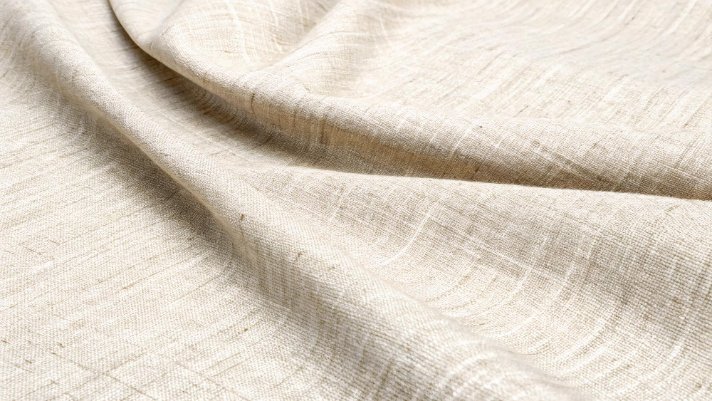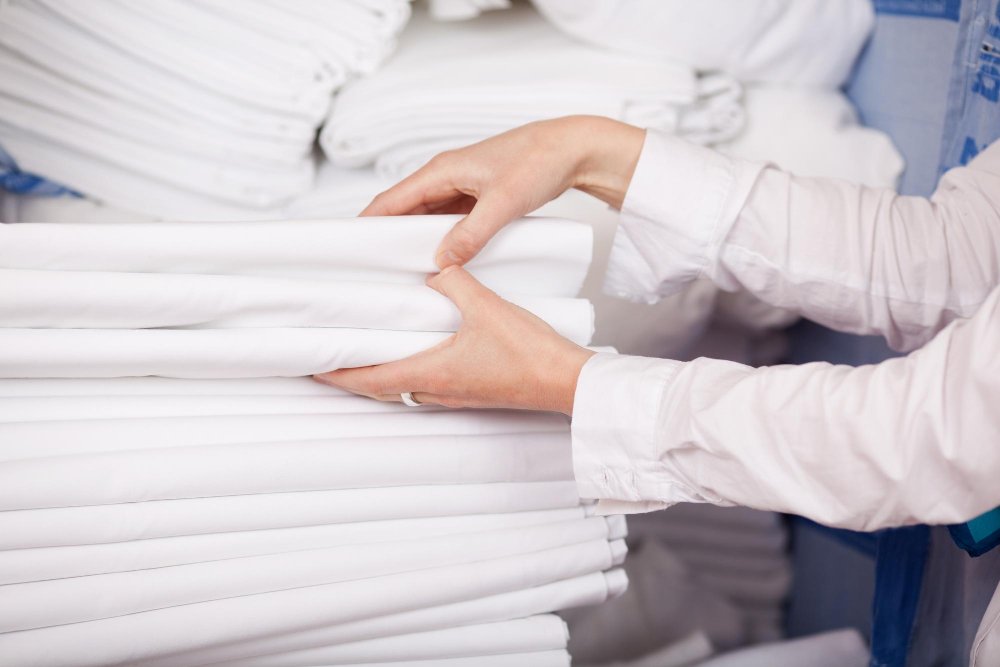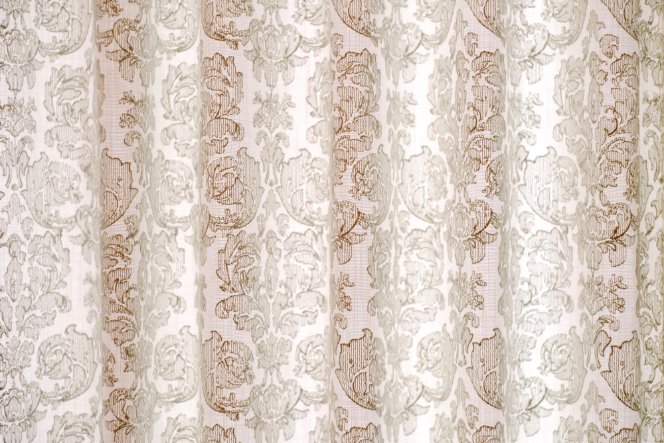Everything you need to know about authentic Irish linen fabric, from its rich heritage to modern production and proper care techniques
Table of Contents
- Understanding Authentic Irish Linen Today
- Rich Heritage and Historical Significance
- What Makes Irish Linen Special?
- The Production Process
- Properties and Scientific Benefits
- Irish Linen vs Other Fabrics
- Uses and Applications
- Complete Irish Linen Care Guide
- Buying Guide: How to Identify Quality Irish Linen
- Frequently Asked Questions
- Conclusion
Understanding Authentic Irish Linen Today
Before we talk about what makes Irish linen special, we need to address an important truth that many sellers won’t tell you: most “Irish linen” today isn’t grown in Ireland.
Here’s the reality. Since the 1950s and 1960s, almost all the flax used for Irish linen comes from France, Belgium, and the Netherlands. These countries now grow most of the world’s quality flax because their climate and farming methods work better for the crop. Ireland’s linen industry has changed a lot over the years, and much of the spinning work now happens in Eastern Europe and China.
So what makes it “Irish” linen? The Irish Linen Guild sets clear rules. For fabric to carry their trademark and be called genuine Irish linen:
- The yarn must be spun in Ireland from 100% flax fibers
- The weaving and design skills must be Irish
- The flax doesn’t have to be grown in Ireland
- Fabric woven outside Ireland, then brought in for dyeing or bleaching, cannot use the Irish Linen Guild logo
Companies like Thomas Ferguson & Co Ltd continue weaving in Ireland, focusing on the highest quality end of the market. These remaining producers concentrate on damask linen and specialty pieces made to custom specifications.
Rich Heritage and Historical Significance
From Celtic Times to the Middle Ages
Linen production in Ireland goes back at least a thousand years. By the 11th century, people were growing flax and using linen for clothing. Early Christian records show saints wearing long linen tunics. This wasn’t just any fabric, it held real value.
In Celtic communities, linen was actually used as a form of currency. Think about that for a moment. People trusted linen so much they traded it like money.
During the 13th century, Irish linen gained recognition beyond the island. Winchester Cathedral in Hampshire, England used Irish linen. Throughout the 14th and 15th centuries, traders exported Irish linen yarn across Europe.
By the 16th century, Irish nobility wore tunics called “leines” made from linen and dyed yellow with saffron. The saffron color wasn’t just pretty, it was a status symbol. However, King Henry VIII tried to limit this in 1536, ordering the town of Galway to stop dying garments with saffron and to limit the amount of cloth used in shirts.
The Golden Age: Belfast as Linenopolis
The real boom started in the 17th century, and it happened partly because of politics and partly because of religious persecution in France.
Ireland was producing wool, but this competed directly with England’s wool industry. The English weren’t happy about this. So Ireland switched focus to linen production, supported by local incentives, tariffs, and taxes.
Around the same time, French Huguenots fled religious persecution in France and brought their amazing weaving skills to Ireland. Louis Crommelin established a model linen factory in Lisburn in the late 1690s. People later called him the “father of the Irish linen industry.”
The Board of Trustees of the Linen Manufacturers of Ireland was established in 1711, setting standards and supporting growth.
By 1764, William Coulson set up his damask workshop in Lisburn, County Antrim. After his death, his sons took over and brought the business to its peak in the mid-19th century. They received royal orders from the Prince Regent and Queen Victoria. The original thatched factory kept producing hand-woven table linen for royal clients until the 1950s.
During the Industrial Revolution, everything changed. Belfast became the center of linen production, earning the nickname “Linenopolis.” At the industry’s peak in the early 20th century, about one-third of Northern Ireland’s entire workforce worked in linen production.
Key Historical Moments
- 11th century: Flax cultivation and linen use documented in Ireland
- 1690s: Huguenots bring advanced weaving techniques
- 1711: Board of Trustees established
- 1764: William Coulson’s royal damask workshop founded
- 1920s: Peak production with 70,000+ workers
The Modern Irish Linen Industry
After World War II, the industry faced serious challenges. Cheaper manufacturing in Asia, the rise of synthetic fabrics, and economic changes hit hard. Many mills closed.
Today’s Irish linen industry is much smaller but more focused. The remaining producers work at the luxury end of the market, creating high-quality pieces that can cost significantly more than mass-produced alternatives. This focus on quality over quantity keeps the tradition alive, even if the scale is nothing like the old days.
For more historical context, visit the Irish Linen Centre & Lisburn Museum collection on Google Arts & Culture.
What Makes Irish Linen Special?
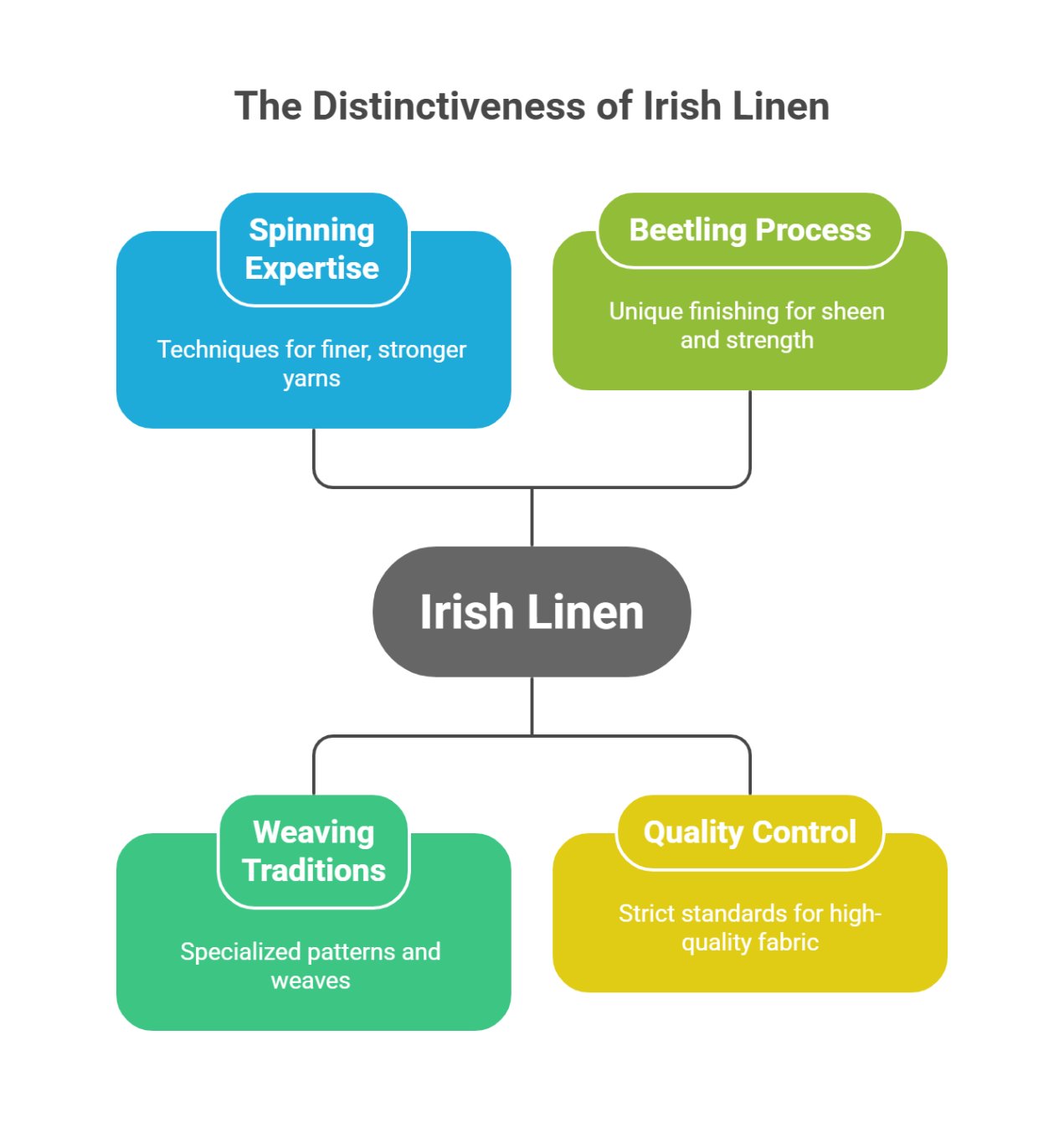
You might wonder: if the flax comes from France or Belgium, what’s actually special about Irish linen?
The answer lies in the skills, techniques, and quality standards developed over centuries of production. Irish linen producers became known for:
Spinning Expertise
Irish spinners developed techniques to create finer, stronger yarns from flax fibers. The spinning process determines yarn quality, and Irish methods produced yarns that were both delicate and durable.
Weaving Traditions
Irish weavers specialized in particular patterns and weaves, especially damask. Plain weave and more complex Jacquard patterns required real skill. The introduction of Jacquard looms around 1830 let Irish weavers create more complex damask designs at better prices.
Beetling Process
This traditional finishing technique is almost unique to Irish linen. The fabric gets dampened and beaten repeatedly with wooden blocks for hours. This creates a distinctive sheen and gives the fabric extra strength and smoothness. Only a handful of beetlers remain in the world, and some are in Ireland.
Quality Control
Generations of experience created strict quality standards. Irish linen producers check every stage of production to make sure the final fabric meets high benchmarks.
The Production Process
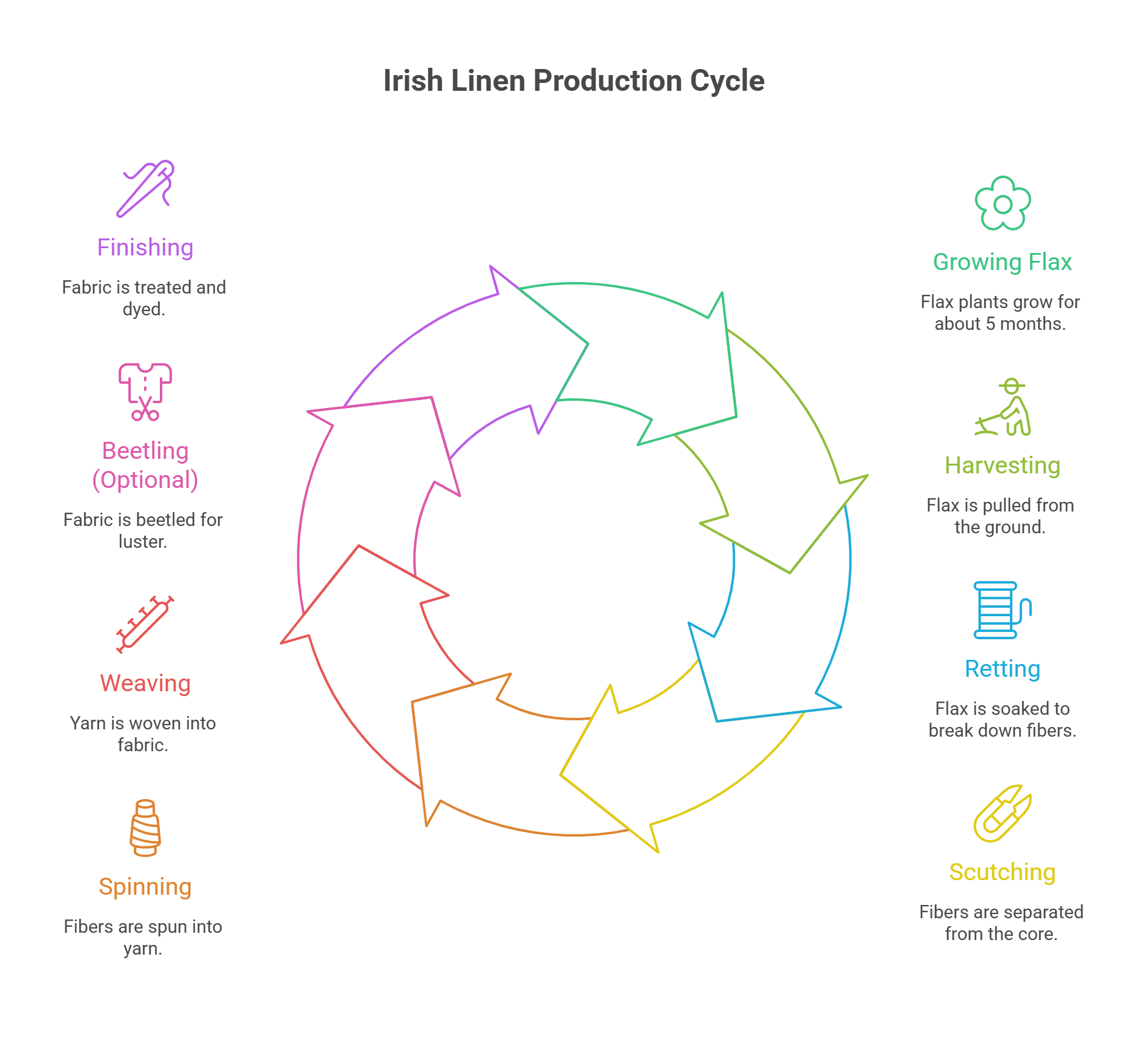
Understanding how linen is made helps explain why Irish linen costs what it does and why it performs so well.
- Growing Flax: Flax plants grow for about 5 months (planted in March, harvested in July). The plants produce beautiful blue flowers and grow best in cool, damp climates.
- Harvesting: Unlike most crops, flax is pulled from the ground rather than cut. This preserves the full length of the fibers, which creates stronger linen.
- Retting: The harvested flax gets soaked in water (or left in fields with dew) for weeks. This process breaks down the material holding the fibers together. The smell is pretty terrible, but it’s necessary.
- Scutching: Workers beat the retted flax to separate the fibers from the woody core. This used to be done by hand with wooden mallets. Now machines handle most of this, but some small producers still use traditional methods.
- Spinning: The cleaned flax fibers get spun into yarn. This is where Irish expertise really matters. Creating fine, even yarn from flax requires skill and experience.
- Weaving: The yarn gets woven into fabric on looms. Simple weaves create basic linen sheeting. More complex patterns need specialized looms and experienced weavers.
- Beetling (Optional): For premium Irish linen, the fabric goes through beetling to add that signature luster and smoothness.
- Finishing: The fabric might be bleached (for white linen), dyed, or treated with special finishes.
This entire process takes months and requires multiple specialists. That’s partly why quality linen costs more than cotton or synthetic fabrics.
Properties and Scientific Benefits
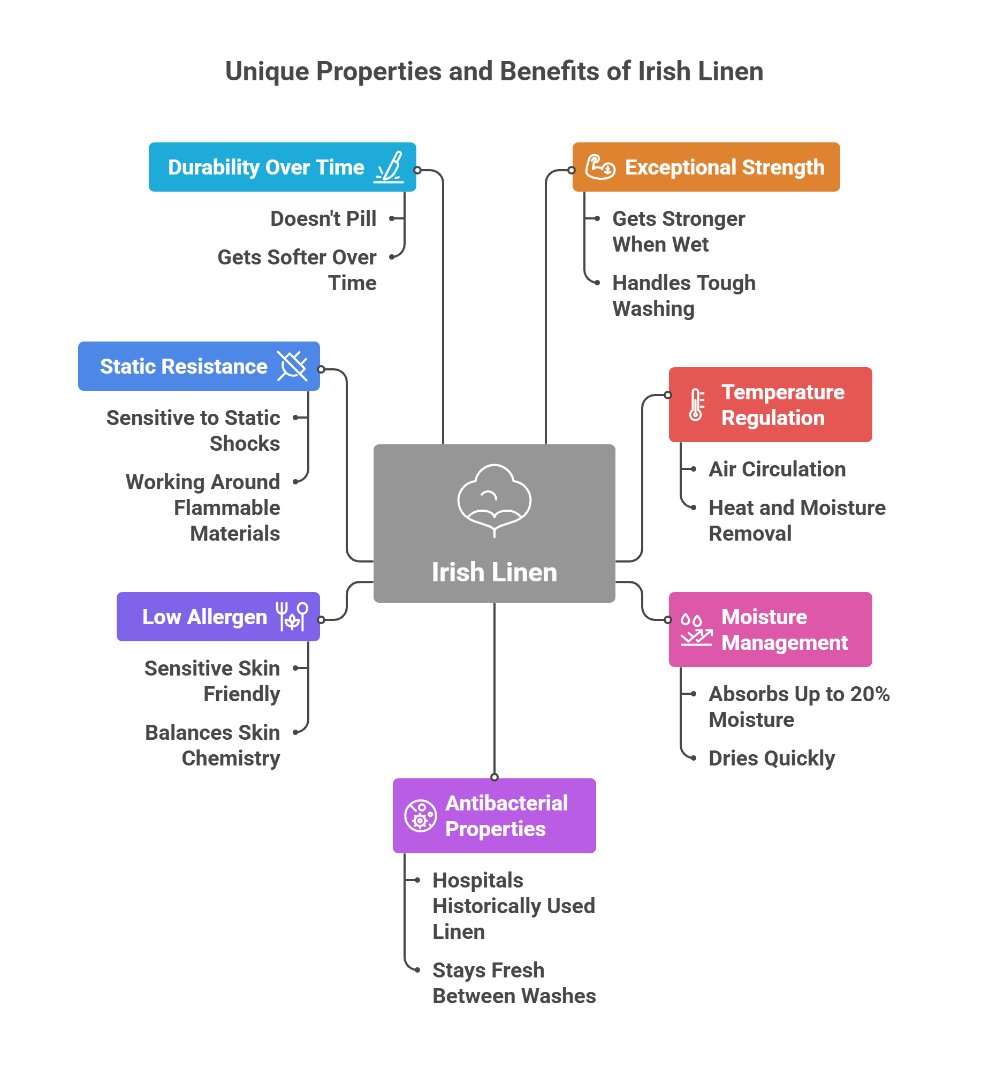
Linen isn’t just another natural fabric. It has some unique properties that make it special for certain uses.
Exceptional Strength
Linen is the strongest natural fiber. But here’s something really interesting: linen gets about 20% stronger when wet. This is why sailing ships used flax linen for sails. It’s also why linen can handle tough washing and actually gets better with each wash.
Temperature Regulation
Linen naturally regulates temperature. Studies show that linen fabrics keep you cooler than cotton in hot weather. The fibers have tiny gaps that allow air to circulate, pulling heat and moisture away from your skin.
Moisture Management
Linen can absorb up to 20% of its weight in moisture before feeling damp. It also dries quickly. This makes it perfect for towels, kitchen linens, and summer clothing.
Antibacterial Properties
Linen naturally resists bacteria and fungi growth. This is why hospitals historically used linen for bedding and why it’s still popular for items that need to stay fresh between washes.
Low Allergen
People with sensitive skin often do better with linen than with synthetic fabrics or even some cottons. Linen doesn’t irritate skin and actually has a slight pH that helps balance skin chemistry.
Static Resistance
Unlike synthetic fabrics, linen doesn’t build up static electricity. This might seem minor, but for people sensitive to static shocks or working around flammable materials, it matters.
Durability Over Time
Quality linen can last for decades. It doesn’t pill or develop those fuzzy fibers that make older cotton feel rough. Instead, linen just gets softer and more comfortable while maintaining its structure.
Irish Linen vs Other Fabrics
How Irish Linen Compares to Cotton
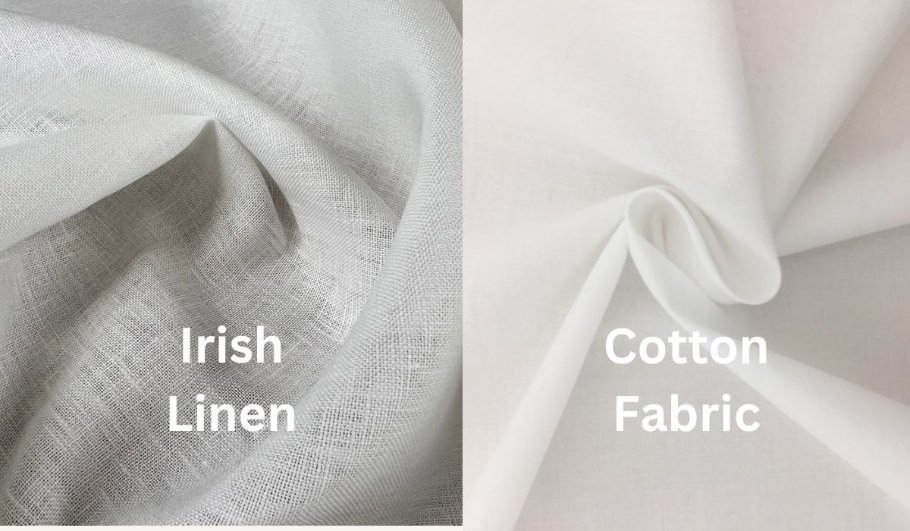
| Property | Irish Linen | Cotton |
|---|---|---|
| Durability | Strongest natural fiber | Moderate strength |
| Strength When Wet | Increases 20% | Decreases slightly |
| Breathability | Excellent | Good |
| Moisture Absorption | 20% of weight | 25% of weight |
| Drying Speed | Fast | Moderate |
| Wrinkle Tendency | High | Moderate |
| Softness Over Time | Increases dramatically | Modest improvement |
| Cost | $$$ (High) | $ (Low to Moderate) |
| Lifespan | Decades | Years |
For more details on caring for different fabrics, see our cotton care guide and linen care guide.
Irish Linen vs Italian Linen
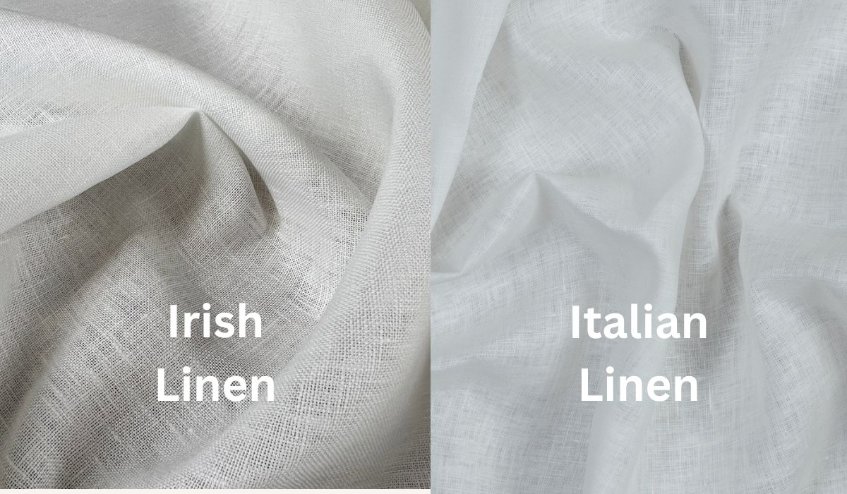
You’ll often see both Irish and Italian linen marketed as premium options. What’s the difference?
Irish Linen
- Coarser texture and hand feel
- More structured drape
- Better for tailored items
- Popular in UK for suits and formal wear
- Traditional beetling creates distinctive finish
- Available in weights from 8oz to 15oz+
Italian Linen
- Softer, smoother texture
- More relaxed drape
- Better for casual shirts and summer wear
- Reflects Italian laid-back style
- Different spinning techniques
- Available in weights from 8oz to 19oz+
Neither is “better,” they’re just different. Choose based on what you’re making and the look you want. For suits and structured items, many people prefer Irish linen. For shirts and relaxed pieces, Italian linen often works better.
You can also find Belgian linen, which sits somewhere between Irish and Italian in terms of texture and hand feel.
Linen vs Silk
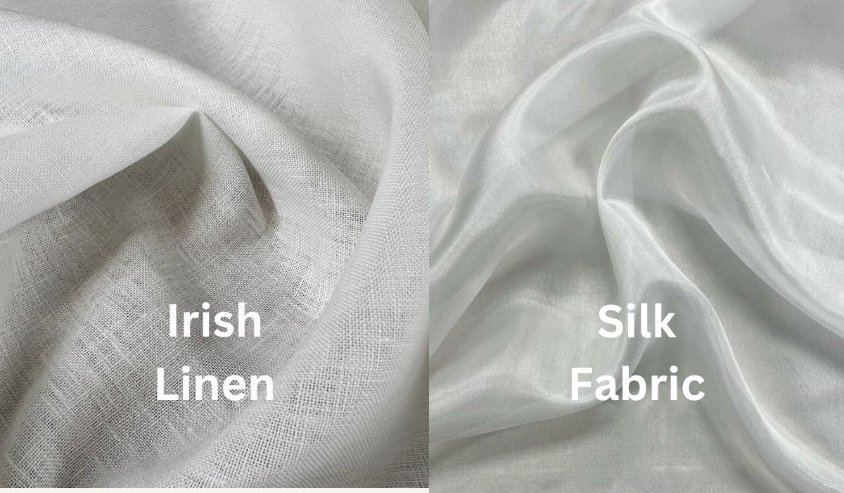
| Aspect | Linen | Silk |
|---|---|---|
| Durability | Very high | Delicate |
| Care Difficulty | Easy (machine washable) | Difficult (often dry clean only) |
| Wrinkle Resistance | Low (wrinkles easily) | Better resistance |
| Temperature Regulation | Excellent in heat | Good year-round |
| Cost | $$$ (High) | $$$$ (Very High) |
| Texture | Textured, natural | Smooth, luxurious |
| Best For | Everyday luxury, summer wear | Special occasions, evening wear |
For more on silk care, check our silk care guide. Or if you’re interested in combining the best of both worlds, learn about satin fabric, which can be made from silk or synthetic fibers.
Uses and Applications
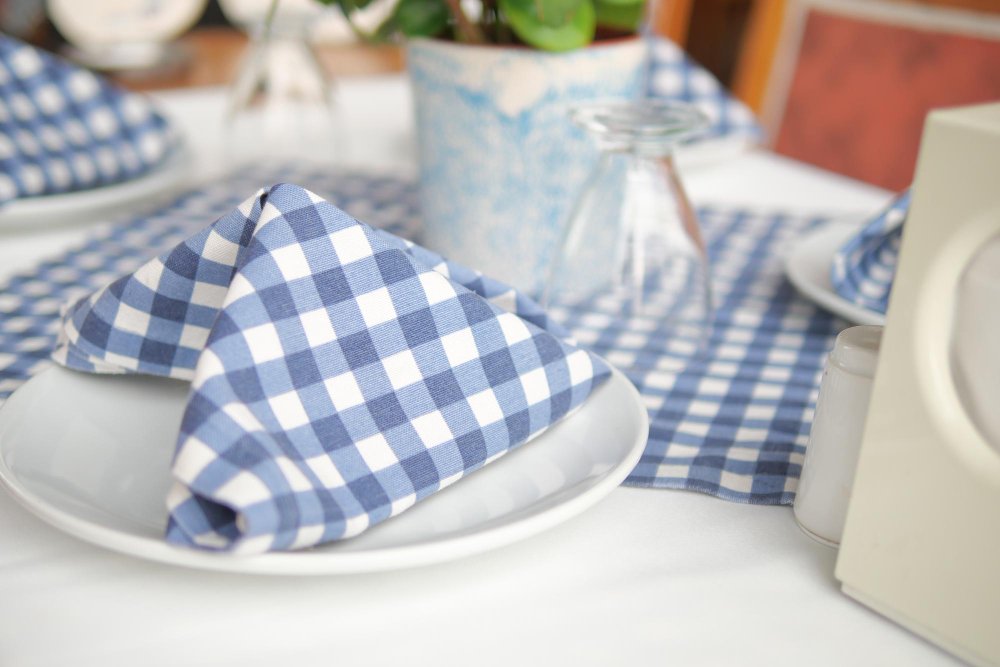
Irish linen works for many different purposes, from everyday items to special heirloom pieces.
Table Linens
This is probably what Irish linen is most famous for. Damask tablecloths and napkins show off the fabric’s beauty while handling the wear and tear of regular use. The natural stain resistance means spills clean up easier than with cotton.
Irish linen tablecloths can serve both casual family dinners and formal celebrations. They get softer with each wash, making them more enjoyable to use over the years.
Bed Linens
Linen sheets are popular for their temperature-regulating properties. They keep you cool in summer and comfortable in winter. Many people find linen sheets help them sleep better than cotton or synthetic options.
Pillowcases and duvet covers made from Irish linen get that wonderful soft, relaxed texture that makes them feel special. For a more casual look, try stonewashed linen bedding.
Kitchen Textiles
Tea towels, dish towels, and aprons benefit from linen’s properties. The fabric absorbs water better than most materials, dries quickly, doesn’t lint (great for drying glassware), and naturally resists bacteria.
For kitchen use, check out our guide to linen towel fabric.
Clothing
Irish linen makes beautiful summer suits, dresses, shirts, and pants. The fabric breathes well, handles heat, and has a natural texture that many people love.
Yes, linen clothing wrinkles easily. But many people see this as part of its charm. The relaxed, slightly rumpled look fits with linen’s casual elegance.
For tailored clothing, consider suiting linen which is woven to handle structure better than lighter weight options.
Home Decor
Curtains, cushion covers, and upholstery made from Irish linen add texture and natural beauty to rooms. The fabric filters light nicely and doesn’t fade as quickly as some other natural materials.
Available in widths up to 120 inches, Irish linen works well for large curtain panels without seams.
Specialty Items
Because of its strength and stability, linen gets used for embroidery backing, bookbinding, and art canvas. Historical documents and important artwork often used linen because people knew it would last.
Complete Irish Linen Care Guide
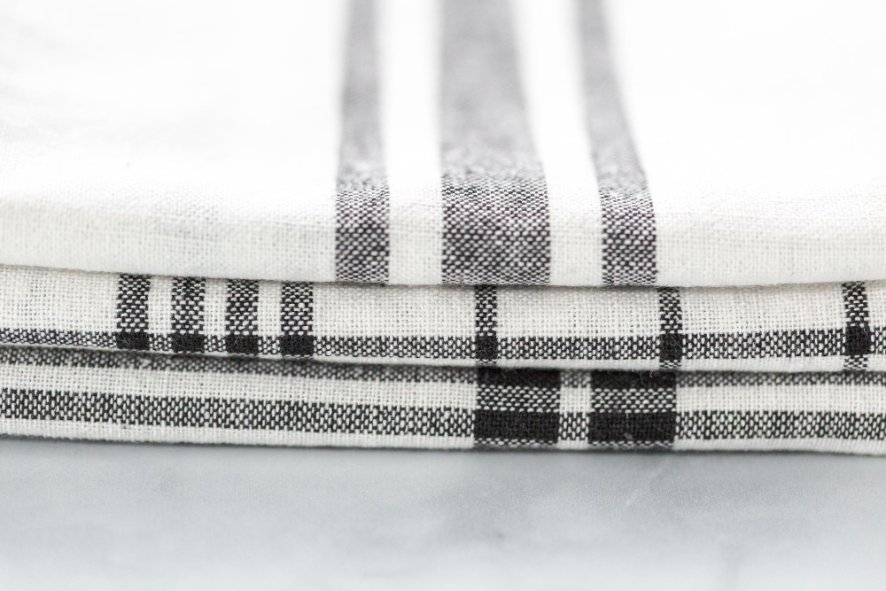
Good news: despite its luxury status, Irish linen is pretty easy to care for. It’s much tougher than silk and more forgiving than many delicate fabrics.
How to Wash Irish Linen
Machine Washing (Recommended for Most Items)
- Check the care label first: Manufacturers consider specific factors like dye type, finishes, and fabric weight. Always follow their instructions.
- Sort your wash: Wash linen separately or with similar colors. Don’t mix linen with rough fabrics like denim that could cause friction damage.
- Use cool or lukewarm water: Set your machine to 30-40°C (86-104°F). White linens without special finishes can handle up to 60°C (140°F), but it’s usually not necessary.
- Choose mild detergent: Use a gentle, liquid detergent without optical brighteners or harsh chemicals. Skip the bleach completely, it weakens linen fibers significantly.
- Select gentle cycle: Use the delicate or gentle setting. Give items space to move freely in the machine. Don’t overload.
- Skip fabric softener: Linen naturally softens with each wash. Fabric softener coats the fibers and reduces absorbency.
Hand Washing (For Delicate or Embroidered Items)
If you have vintage pieces, items with hand embroidery, or fabric with special finishes:
- Fill a clean basin with cool water
- Add a small amount of mild detergent
- Submerge the linen and gently swish (don’t wring or twist)
- Let soak for 10-15 minutes
- Rinse thoroughly with cool water until detergent is gone
- Press out excess water gently (don’t twist)
For more detailed washing instructions, use our Linen Care Checklist.
Drying Methods
Air Drying (Best Method)
Air drying is the gentlest option and helps linen maintain its quality:
- Hang or lay flat: Hang items on a line or drying rack, or lay flat on a clean surface
- Avoid direct sunlight for colored items: While white linen benefits from sun bleaching, colored linen can fade
- Don’t use clothespins on visible areas: They leave marks in the fabric
- Smooth out wrinkles while damp: This makes ironing easier later
Tumble Drying (Use Sparingly)
If you must use a dryer:
- Select the lowest heat or air-dry setting
- Don’t over-dry, remove when items are still slightly damp
- Expect more wrinkles than with air drying
- Be aware that frequent tumble drying shortens fabric life
Ironing and Steaming
If you prefer a crisp, smooth look:
Ironing Tips
- Iron while damp: This is the most important tip. Linen irons much easier when slightly damp
- Use medium to high heat: Linen can handle high temperatures (unlike synthetic fabrics)
- Iron on wrong side first: This removes wrinkles without the risk of shine marks
- Flip and iron right side: This brings out the natural luster
- Use a water spray if fabric is dry: Mist lightly and let water absorb before ironing
Steaming
A garment steamer works well for linen clothes. Hang the item and steam it, pulling gently to remove wrinkles. This method is gentler than ironing and helps the fabric maintain its natural texture.
How to Soften Linen Quickly
If you have new linen that feels stiff, here’s a quick method to soften it faster:
Remember, even without special techniques, your Irish linen will naturally soften with each wash. The more you use it and wash it, the softer and more comfortable it becomes.
Proper Storage
Good storage prevents damage and keeps your Irish linen in good condition:
- Store in cool, dry places: Avoid bathrooms, basements, and exterior walls where moisture builds up
- Ensure good ventilation: Air circulation prevents moisture damage and mildew
- Keep away from direct sunlight: Long-term sun exposure weakens fibers and causes fading
- Use breathable storage: Store in cotton bags or on shelves, not in plastic containers that trap moisture
- Fold loosely: Tight folds over long periods can create permanent creases
- For valuable pieces: Wrap in acid-free tissue paper
Stain Removal
Linen’s smooth surface helps stains shed more easily than with many fabrics. The key is acting quickly.
General Stain Treatment
- Blot immediately: Use a clean cloth to blot (never rub) fresh stains
- Use cold water: Hot water can set protein-based stains
- Try vinegar solution: Mix cold water with white vinegar (1:1 ratio) and dab on stain
- Let it sit: Give the solution 10-15 minutes to work
- Wash normally: Follow your regular washing routine
Specific Stains
- Wine: Blot immediately, then pour salt on the stain to absorb liquid. Rinse with cool water and wash
- Oil or grease: Apply a small amount of dish soap directly to the stain before washing
- Coffee or tea: Rinse with cool water immediately, then treat with mild detergent
- Ink: Dab with rubbing alcohol, then wash (test on hidden area first)
Check our interactive Linen Care Calculator for personalized washing instructions based on your specific linen items.
Buying Guide: How to Identify Quality Irish Linen
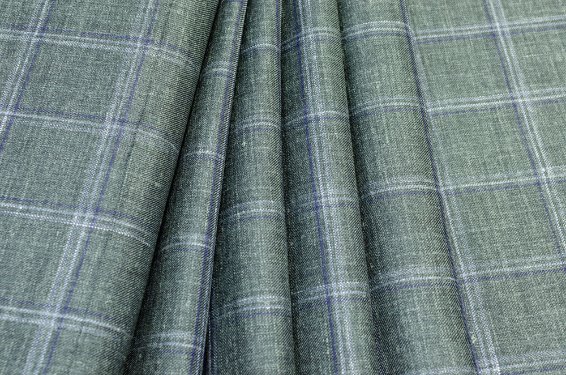
Why Is Irish Linen So Expensive?
Several factors contribute to the high cost:
- Labor-intensive production: From growing to weaving, linen takes much more time and skill than cotton or synthetics
- Long growing cycle: Flax takes 5 months to grow, and harvesting must be timed perfectly
- Specialized skills: Creating fine linen requires experienced spinners and weavers
- Traditional techniques: Processes like beetling are done by only a few remaining specialists
- Lower yields: Flax produces less fiber per acre than cotton
- Rarity: With only about 8 producers left in Ireland, supply is limited
- Quality control: Rigorous standards mean more fabric gets rejected during production
How to Identify Irish Linen Fabric
With so much fabric labeled as “linen,” how do you know you’re getting the real thing?
Look for the Irish Linen Guild Trademark
This is your best guarantee. The trademark ensures the fabric meets specific standards. However, this logo only appears on fabric woven in Ireland, not on finished products made elsewhere from Irish linen fabric.
Physical Tests
- Weight and thickness: Quality linen feels substantial. It should have body and drape well
- Texture: Real linen has slight texture and natural slubs (small irregularities in the yarn). Perfect smoothness often indicates a blend or synthetic
- Sound: Linen makes a distinct crisp sound when handled, especially new fabric
- Water test: Linen absorbs water quickly without water beading on the surface
- Wrinkle test: Crumple the fabric. Real linen wrinkles immediately and significantly
Check the Label
- Should state “100% linen” or “100% flax”
- May specify “Irish linen” or show the Irish Linen Guild mark
- Lists the manufacturer (helpful for researching authenticity)
- Includes care instructions appropriate for linen
Best Brands for Irish Linen
These manufacturers continue the Irish linen tradition:
- Thomas Ferguson & Co Ltd: Established 1854, one of the last remaining weavers of Irish linen damask in Banbridge, County Down
- William Clark & Sons Ltd: Known for high-quality linen fabrics
- Brooklinen: Uses Irish linen for some of their premium bedding lines
- Givan’s Irish Linen: Incorporated 1899, acquired by Samuel Lamont & Sons Limited in 1960
When shopping online, look for sellers who provide detailed information about the fabric’s origin and can verify it comes from Irish producers.
What Is the Biggest Irish Brand?
While linen production is now limited, Thomas Ferguson Irish Linen is widely recognized as one of the most prestigious remaining producers. They’re acknowledged as one of the finest Jacquard weavers in the world and maintain the highest quality standards.
However, many brands that sell “Irish linen” products source their fabric from Irish producers but manufacture the finished items elsewhere. This is perfectly legitimate (and actually follows Irish Linen Guild rules for labeling), but it’s worth knowing the distinction.
Price Guidelines
Expect to pay:
- Fabric (per yard): $25-$55 depending on width and quality
- Standard width (58″): $25-$35 per yard
- Wide width (120″): $42-$55 per yard
- Finished tablecloths: $80-$300+ depending on size and damask pattern
- Napkins: $10-$25 each for quality damask
- Bed sheets (per set): $200-$600+
If you find “Irish linen” at bargain prices, be skeptical. It might be a blend, lower quality linen from other sources mislabeled as Irish, or fabric that doesn’t meet the Irish Linen Guild standards.
Use our Linen Quality Quiz to test your ability to identify high-quality linen.
Frequently Asked Questions
Yes, Irish linen can shrink, especially if washed in hot water or dried on high heat. Expect 3-5% shrinkage with the first wash. To minimize shrinkage, wash in cool or lukewarm water (30-40°C) and air dry. Once linen has been washed a few times, further shrinkage is minimal. Many manufacturers pre-wash their linen to prevent this issue.
“Regular linen” can come from anywhere and may have varying quality standards. Irish linen specifically refers to linen where the yarn is spun in Ireland from 100% flax (according to Irish Linen Guild standards), with Irish design and weaving skills. Irish linen producers also use traditional finishing techniques like beetling that create a distinctive luster. The quality control and expertise developed over centuries make Irish linen stand out.
Yes, but on a much smaller scale than historically. About 8 linen producers remain in Ireland today, down from thousands during the industry’s peak. These surviving companies focus on high-quality specialty items rather than mass production. The flax typically comes from France, Belgium, or the Netherlands, but the spinning, weaving, and finishing happen in Ireland.
Look for these signs: substantial weight and thickness, even weave with minimal thick or thin spots (some natural slubs are normal and desirable), crisp hand feel that softens with washing, good drape, and proper labeling. The fabric should wrinkle easily (if it doesn’t, it might be a blend). Quality linen also has a distinctive crisp sound when handled.
This can happen if you use too much detergent, wash in very hard water, or use fabric softener. Try washing with less detergent in the next cycle. Hard water can also cause stiffness, adding a small amount of white vinegar to the rinse cycle helps. Never use fabric softener on linen as it coats the fibers. The fabric should soften naturally with each wash.
It’s better to wash linen separately or with similar fabrics. Avoid washing linen with rough fabrics like denim or items with zippers and hardware that could snag the linen. You can wash linen items together regardless of color after the first few washes, once you’re sure colors won’t bleed.
With proper care, Irish linen can last for decades. Many families pass down Irish linen tablecloths and bed linens through multiple generations. The fabric gets softer and more beautiful with age while maintaining its structural integrity. This longevity is one reason Irish linen is worth the higher initial cost.
If you want quality fabric that will last for years or even decades, yes. Irish linen is an investment piece. Calculate the cost per use over 20-30 years, and it becomes quite reasonable compared to cheaper options you’ll need to replace multiple times. The fabric also gets better with age rather than wearing out. However, if you need something for short-term use or aren’t willing to provide proper care, less expensive options might make more sense.
Conclusion
Irish linen represents more than just a fabric. It’s a connection to centuries of craftsmanship, a testament to quality that lasts, and a material that gets better the more you use it.
The industry has changed dramatically from its peak in the early 1900s when Belfast earned the name “Linenopolis” and one-third of Northern Ireland worked in linen production. Today, only about 8 producers remain, focusing on the highest quality items rather than competing with mass production.
This shift toward quality over quantity means that when you buy authentic Irish linen, you’re getting fabric that meets rigorous standards and reflects specialized skills developed over generations.
Key Takeaways
- Check for authenticity: Look for the Irish Linen Guild trademark. Remember that “Irish linen” means the yarn is spun in Ireland from 100% flax, even if the flax itself comes from France, Belgium, or the Netherlands.
- Understand the investment: Irish linen costs more than regular linen or cotton because of labor-intensive production, specialized skills, and limited supply. Calculate cost over decades of use, not just the initial price.
- Care is simple: Despite its luxury reputation, Irish linen is easy to maintain. Machine wash in cool water with mild detergent, air dry when possible, and iron while damp. The fabric gets softer and more beautiful with each wash.
- Expect wrinkles: Linen wrinkles easily. This is a feature, not a flaw. Many people love the relaxed texture. If you prefer crisp fabric, plan to iron (which is easy when the fabric is damp).
- Choose the right type: Irish linen has a coarser texture than Italian linen, making it better for structured items and formal pieces. Consider your specific use when choosing between different linen types.
- Buy from reputable sources: With so few producers remaining, make sure you’re buying from sellers who can verify the origin of their fabric. Unusually low prices are a red flag.
- Think long-term: Irish linen is made to last for decades. Choose colors and patterns you’ll still love years from now. Classic white and neutral tones remain popular for good reason.
Final Recommendations
If you’re new to Irish linen, start with something small like tea towels or napkins. This lets you experience the fabric’s properties without a huge investment. You’ll quickly understand why people are willing to pay more for quality linen.
For those ready to invest in larger pieces, prioritize items you’ll use frequently. Bed linens or a tablecloth for your dining table make sense because you’ll use them regularly and benefit from linen’s properties every time.
Remember that Irish linen is an investment in quality, sustainability, and timeless style. Unlike fast fashion or disposable home goods, Irish linen improves with age and can become a family heirloom. In a world of planned obsolescence, that’s something special.
Whether you’re drawn to Irish linen for its rich history, exceptional durability, or beautiful aging process, you’re choosing a fabric that has proven its worth over centuries of use. With proper care, your Irish linen pieces will serve you well for years to come, getting softer and more comfortable while maintaining the strength and character that made Irish linen famous around the world.
For more information about linen care and fabric selection, explore our comprehensive guides on linen fabric and related textile topics. And visit the Irish Linen Centre & Lisburn Museum to learn more about the rich history of Irish linen production.

